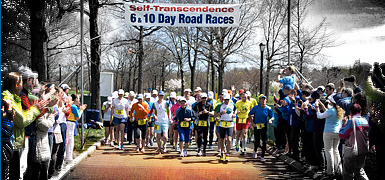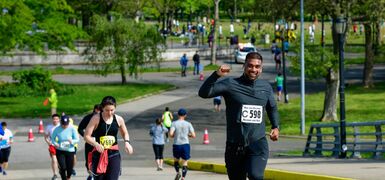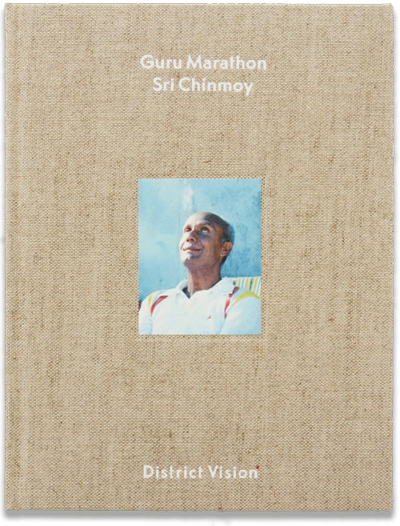Szczesiul, Sahishnu. "Georgs Jermolajevs Proves His Mettle at Sri Chinmoy Ultra." Ultrarunning. December 1995.
Day 12, 9:32 p.m.
As the wind howls from the south and the rain blows in thick across the river, a humble, gray-haired, thin man with a broad smile etched on his face emerges from the shadows along the course and nimbly heads through to finish of another lap. The multi-day specialis has challenged his capacity for another one-mile tour of Wards Island Park. '903 miles, Georgs.
He passes the counting tent, lifting his gaze from the road to acknowledge the lap monitor, and keeps going. He grabs a cup of water and a piece of cornbread from the kitchen, and passes the dimly lit barracks that is his temporary home. He has travelled 8,300 miles to run on this one-mile loop and his task is formidable. He runs without a handler and is supplied with four pairs of blowout running shoes.
His is one of the 19 stories that made up this year’s Ultra Trio epic. The race with staggered starts, mileage cutoffs, and endless hours for contemplation is in full swing – the annual multi-day pictorial about courage, capacity, and will power in the face of injury, fatigue and up to 1,300 miles logged on New York City park roads.
The story begins on September 11 as three runners toe the line for the start of 1,300 miles. Izumi Yamamoto, the only woman in the race and a last-minute entrant, must start with the men. She has participated in several of the super-long races. Miki Shiraki, Japanese Warrior masquerading as a placid businessman from Kansas, is looking for a chiropractor – his doctor told him not to run until is back heals. He is running anyway. Georgs Jermolajevs, 52 and graing, should probably be home in Riga, Latvia, looking for an extra job to support his struggling family. Conditions in his country are difficult: high unemployment and scarcity of goods, especially food. This past May, Georgs set a course record of 578 miles in the Sri Chinmoy Seven-Day Race here in New York and is eager to test his fitness after a good summer of training.
At noon the race starts with little fanfare but great tradition. Only eight runners have ever completed 1,300 miles within the time limit. Necessitating an average of 72 miles a day, the difficulty of this race is obvious. Jermolajevs runs 121 miles the first day, with the game but injured Shiraki at 101, and Izumi falling sick and clocking 64 miles.
Two days later the women’s field starts the 1,000-mile race. The group of four include: Hildegard Schmidhuber, a running grandmother who ran the 700-mile race in 1988, defeating several of the men; Nirjhari DeLong, a veteran of over a dozen multi-days; Karen Bolliger, a young Swiss runner who has several multi-days to her credit as well as a successful swim of the English Channel; and 28-year-old Canadian Dhvaja Dorn, who last year ran 700 miles and has improved with every race.
Just before they start, Georgs comes around the bend for 215 miles after 48 hours: a second ay split of 94 miles. Miki can hardly run for more than 20-minutes intervals because of his strained back muscles and sciatic problems. Izumi is bothered by an upset stomach and dizziness, even though the weather conditions are good. She might not last either. He 1,000-mile women proceed cautiously, with Hildegard topping 86 miles on the first day.
The next day only two men start the 1,000-mile race. Fifty-seven-year-old Don Winkley from Corpus Christi, Texas, has had quite a summer, finishing the Moonbat Trans Am as the oldest finisher in the four-year history of that race. Now barely a month later, he tries the race that defeated him last year when fatigue reduced him to a crawl and only 700 miles after 15 days. Aleksandar Arsic from Yugoslavia, a relative youngster at age 31, had run second overall in the 700 last year. He appears ready to mount the challenge of 67 miles a day that the 1,000-mile race requires.
And at this point, after three days of running, Georgs maintains his form in the 1,300 with a 73-mile day and a cheerful demeanor. He is running faster than the men who just started. The good weather holds as the small group of runners work to maintain their hopes for success.
As the 700-mile women prepare for their start, Georgs passes 431 miles for five days while Miki and Izumi are all but out of the race. Dhvaja’s 16 miles behind Hildegard in the 1,000-mile event, with Nirjhari looking strong in second place. Alek maintains a five-mile lead on Don.
Four women join the fray at 700 miles. The strong favorite, Dipali Cunningham of Australia, is one of the best at the distance. Last year she ran 700 miles in ten days five hours for the overall victory. Canadian Barbara McLeod at 57 another age-group pioneer, has trained hard but was hit by a car while out running in Ontario. Her ailments have seemed to improve a bit by race day so she appears for the event. Mariana Nagy, 22, from Budapest, Hungary, ran 300 miles of the 700 last year and is confident of her ability this time. And Gabriele Zimmermann from Austria rounds out the women’s filed as the only novice runner.
Dipali cruises to 100 miles the first day, with Barbara 23 miles behind as closest pursuer.
Now six days into the Trio, six men begin the 700-mile, bringing the total to 19 runners from 11 countries. None of the six have ever completed the distance and three are multi-day novices. Scott Weber from Colorado, Ed Fishman from Hawaii, and Method Istvanik from Pennsylvania are the veterans; Robin Holder from New York, Sasha Djordevic from Yugoslavia, and Tony Munoz from Mexico are the neophytes.
At the same time as the men begin, Jermolajevs passes 492 miles for his six-day split. Miki barely makes the cutoff. Don Winkley leads Alek by a scant five miles with 218 in the 1,000-miler with 268 miles; her gave firmly set on the road ahead and the task at hand.
The Ultra-Trio originally started as a 1,000-mile race in 1985. Don Choi, an American pioneer in multi-days, cruised to victory in 15 days three hours, one of three finishers. 1986 saw Stu Mittleman create a new standard, running 1,000 miles in 11 days, 20 hours,, days ahead of four other finishers. In 1987 Sri Chinmoy, creator of this running saga and himself a master of self-transcendence, upped the ante and created the Trio – 1,300-, 1,000-, and 700-mile races. That year no one completed the distances in the allotted time. In 1988, Greek Yiannis Kouros set another 1,000-mile standard with a brilliant performance of ten days, ten hours. Included din his totals were splits for six days at 639 miles, eight days at 810, and ten days at 964 miles. Sandy Barwick of New Zealand set a women’s best at 1,000 miles of 14 days and 20 hours. Still no one set a women’s best at 1,300 miles.
In 1989 At Howie from Canada was the first finisher at 1,300 miles in 17 days eight hours, followed by two others. It could be done! Suprabha Beckjord of Washington, D.C., broke Barwick’s female record that year by 27 minutes. In 1991 Al Howie broke his own record in the 1,300 by 13 hours (16 days, 19 hours). In 1993 Istvan Sipos of Hungary grabbed the 1,300 standard with a solid, steady run of 16 days, 17 hours.
Runners often look to someone else’s standard to test their own capacity. But the super-long race requires an extra amount of resiliency and imagination. To constantly convince mind and body to keep going is often job one. To attain a high level of confidence is job two. To actually run 72 miles day for 18 days or 67 miles a day for 15 days is testament to great inner fortitude. Having said all this, as a race director I wondered whether we would have any finishers this year. But the runners always surprise one with their resolve and determination. This year’s event, although smaller in numbers, did not lack the luster of pervious years.
Georgs continues his quest for recognition in the 1,300-miler. He passes 1,000 miles in 12 days, 20 hours, which is a world over -50 best. He runs fast laps or groups of laps, sometimes at sub-nine or even sub-eight-minute pace, often for five or ten miles in succession. Then he resorts to stretches o fast-paced walking at 13 or 14 minutes a mile. Without a handler, he is at a disadvantage in attempting a record or even finishing. But he devises ways of leaving extra food for himself along the course, as well as getting every ounce of support out of his well-worn shoes. He never asks for a wakeup call, preferring to get up on his own when he is ready to run. After 13 days Georgs has placed himself ahead of Istvan Sipos’ record pace from 1993. He is averaging almost 78 miles a day and showing no signs of slowing. On day 15 he runs 856 miles, which virtually clinches a new record. At 2:30 a.m. on Thursday, September 28, Georgs Jermolajevs completes his record run, in 16 days 15 hours 28 minutes and 19 seconds. Emotionally moved, he hugs everyone in sight. Moments like this make a race of this length totally special and worthwhile. His satisfaction suddenly becomes everyone’s.
In the women’s 1,000-miler, Dhvaja Dorn assumes the lead over Hildegard on the 12th day and never looks back. She becomes the youngest finisher of 1,000 miles, doing so in 15 days 22 hours. Hildegard struggles to 860 miles and complete exhaustion by the race end, but expresses gratitude for the experience. In the men’s race, Don Winkley holds a substantial head of 90 miles over Aleksandar, but meets with disappointment after 12 days. Extreme fatigue forces him off the road with only 180 miles to go. He finishes at 913 miles, bringing his total racing mile for the year to over 4,000, but with a little unfinished business. Aleksandar finishes at 903 miles, happy and determined to finish next time.
Dipali Cunningham once again showed her tremendous capacity in the multi-days, hitting the 700-mile finish line first. Her time of nine days 15 hours ranks second only to Sandy Barwick’s world best of eight days 15 hours. Dipali was never challenged by any other runner in the 700. She prefers shorter ultras and so only competes occasionally in the multi-days. She has won the Sri Chinmoy International Invitational 47-miler 12 times. Dipali’s great run seemed to inspire Gabriele, who withstands painful shin splints to reach her 700-mile goal in 12 days nine hours. Mariana Nagy also catches fire the last two days to finish with just one hour and 20 minutes to spare.
The 700-men keep close distance between each other, with walker/runner Robin Holder the early leader. At four days 72-year-old Ed Fishman is only 12 miles behind Holder. But at day six, Sasha Djordevic, 24, from Yugoslavia begins to assert his strength. In only his third ultra and first multi-day Sasha finds the reserve to run through his injuries. On the last day he carves out 75 miles to make the 700-mile mark, the only man to clear the 700 barrier, and with only 12 minutes to spare. Ed Fishman deserves recognition for his fine performance – he tops 335 miles for six days, an age group 70-74 record (pending ratification). Fishy has been seen dancing along the course numerous times. The Hawaiian must like that New York air!
With 11 super-long races, including nine ultra-trios under its belt, the Sri Chinmoy Marathon Team is intending to make 1996 a banner year for multi-days. The Seven Day Race will now become a ten-day affair, April 25 to May5, 1996. The Ultra-Trio will retain its fall schedule. And the long-awaited 2,700-mile race will hopefully begin on June 13th, with a 47-day cutoff (location to be announced). We invite any and all individuals with ultra experience and a need to test their limits to consider a multi-day.
You never know what you have or what you are until you try. As Sri Chinmoy says, ‘The fullness of life lies in dreaming and manifesting the impossible dream.’ Good luck to all our friends seen or unseen who run ultras.





